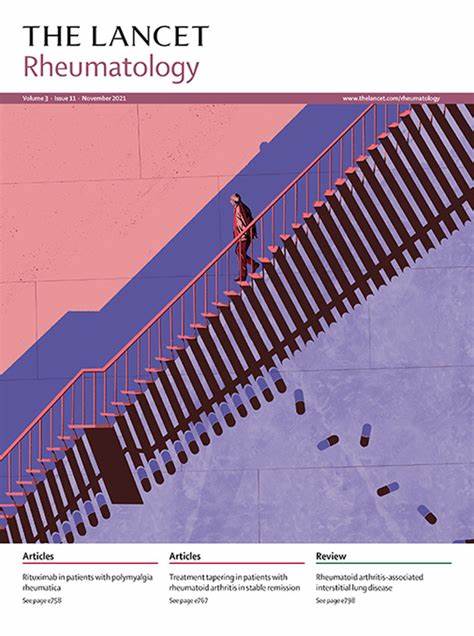Treatment outcomes in patients with VEXAS syndrome: a retrospective cohort study
IF 16.4
1区 医学
Q1 RHEUMATOLOGY
引用次数: 0
Abstract
Background
Vacuoles, E1 enzyme, X-linked, autoinflammatory, somatic (VEXAS) syndrome is a recently described autoinflammatory disorder with little therapeutic evidence. We compared treatment outcomes of targeted therapies versus prednisolone alone in the largest UK cohort of patients with VEXAS syndrome to date.
Methods
In this retrospective cohort study, we analysed the outcomes of targeted therapies in patients with VEXAS syndrome in six tertiary referral centres across the UK between July 22, 2014, and Oct 19, 2024. The inclusion criteria were genetically confirmed VEXAS syndrome and receipt of at least one targeted therapy or prednisolone alone. Patients without clinical information at all timepoints after baseline were excluded. Data collection forms were used to record clinical and biochemical data at the following timepoints: time of diagnosis, initiation of treatment, and follow-up at 3 months, 6 months, and 12 months from the initiation of treatment (±28 days). Laboratory parameters, including C-reactive protein (CRP) and haemoglobin, and glucocorticoid doses were collected at each timepoint and compared between timepoints. Primary outcomes were complete response (ie, clinical remission, CRP ≤10 mg/L, and prednisolone ≤10 mg per day) and partial response (ie, clinical remission with ≥50% reductions in both CRP and glucocorticoid dose from baseline) to treatment. Treatment discontinuation and adverse events were documented for each treatment. Due to the high prevalence of cytopenias in VEXAS syndrome, these were only recorded as adverse events when necessitating treatment change. People with lived experience were not involved in the study.
Findings
We analysed 71 targeted therapies in 59 patients with genetically confirmed VEXAS syndrome. Of the 59 patients, 58 (98%) were male and one (2%) was female, with a mean age of 71 years (SD 8), and 27 (46%) had myelodysplastic syndrome. The treatments included tocilizumab (n=19), anakinra (n=13), azacitidine (n=13), baricitinib (n=11), and prednisolone only (n=10). At 6 months, in those who continued therapy, ten (91%) of 11 patients receiving azacitidine showed a response (three [27%] complete responses), as well as did seven (64%) of 11 receiving tocilizumab (four [36%] complete responses), three (100%) of three receiving anakinra (one [33%] complete response), and two (40%) of five receiving baricitinib (no complete responses). Although all patients who tolerated anakinra had a response, the discontinuation rate was high (eight [62%] of 13), mostly due to severe injection-site reactions (n=5). Patients were more likely to respond to azacitidine than to other therapies at 6 months (risk ratio 2·47, 95% CI 1·18–5·20; p=0·018). Absence of fever or thromboembolism at diagnosis was associated with better outcomes. By 6 months, median CRP concentrations had decreased in patients receiving tocilizumab (from 30 mg/L [IQR 13–45] to 4 mg/L [3–37]) or anakinra (from 18 mg/L [11–52] to 2 mg/L [1–28]), whereas azacitidine showed the greatest increase in haemoglobin (from mean concentration 104 g/L [SD 17·5] to 120 g/L [14·4]). 28 (39%) of 71 treatments were discontinued, most commonly due to serious adverse events (12 [17%]) and death (nine [13%]). Infections were most frequent with azacitidine (eight [62%] of 13) and tocilizumab (nine [47%] of 19).
Interpretation
In this UK cohort of patients with VEXAS syndrome, azacitidine and tocilizumab showed superior effectiveness compared with anakinra, baricitinib, and prednisolone only. Treatment selection should consider individual risk factors and tolerability. Prospective studies are needed to confirm optimal treatment strategies and develop standardised protocols.
Funding
None.
VEXAS综合征患者的治疗结果:一项回顾性队列研究
背景:空泡,E1酶,x -联,自身炎症,躯体(VEXAS)综合征是最近发现的一种自身炎症疾病,治疗证据很少。我们在迄今为止英国最大的VEXAS综合征患者队列中比较了靶向治疗与单独强的松龙的治疗结果。方法:在这项回顾性队列研究中,我们分析了2014年7月22日至2024年10月19日期间英国六家三级转诊中心对VEXAS综合征患者进行靶向治疗的结果。纳入标准为遗传学上证实的VEXAS综合征,并接受至少一种靶向治疗或单独使用强的松龙。排除基线后所有时间点无临床信息的患者。采用资料收集表记录诊断时间、开始治疗时间、开始治疗后3个月、6个月、12个月(±28天)随访时间的临床及生化资料。在每个时间点收集实验室参数,包括c反应蛋白(CRP)和血红蛋白,以及糖皮质激素剂量,并在时间点之间进行比较。主要结局是治疗完全缓解(即临床缓解,CRP≤10mg /L,强的松龙≤10mg / d)和部分缓解(即临床缓解,CRP和糖皮质激素剂量较基线均降低≥50%)。记录了每次治疗的停药和不良事件。由于在VEXAS综合征中细胞减少的高发率,这些仅在需要改变治疗时才被记录为不良事件。有生活经验的人没有参与这项研究。研究结果:我们分析了59例经基因证实的VEXAS综合征患者的71种靶向治疗方法。59例患者中,58例(98%)为男性,1例(2%)为女性,平均年龄71岁(SD 8), 27例(46%)患有骨髓增生异常综合征。治疗包括tocilizumab (n=19), anakinra (n=13), azacitidine (n=13), baricitinib (n=11)和泼尼松龙(n=10)。在6个月时,在继续治疗的患者中,11名接受阿扎胞苷治疗的患者中有10名(91%)出现反应(3名[27%]完全缓解),11名接受托珠单抗治疗的患者中有7名(64%)出现反应(4名[36%]完全缓解),3名接受阿那单抗治疗的患者中有3名(100%)出现反应(1名[33%]完全缓解),5名接受巴西替尼治疗的患者中有2名(40%)出现反应(无完全缓解)。虽然所有耐受anakinra的患者都有反应,但停药率很高(13例中有8例[62%]停药),主要是由于严重的注射部位反应(n=5)。6个月时,患者对阿扎胞苷的应答率高于其他治疗(风险比2.47,95% CI 1.18 - 5.20;p = 0·018)。诊断时无发热或血栓栓塞与较好的预后相关。6个月后,接受托珠单抗(从30mg /L [IQR 13-45]降至4mg /L[3-37])或阿那单抗(从18mg /L[11-52]降至2mg /L[1-28])治疗的患者CRP中位浓度下降,而阿扎胞苷的血红蛋白增幅最大(从平均浓度104g /L [SD 17.5]升至120g /L[14.4])。71例治疗中有28例(39%)停止治疗,最常见的原因是严重不良事件(12例[17%])和死亡(9例[13%])。阿扎胞苷(8例[62%]/ 13例)和托珠单抗(9例[47%]/ 19例)感染最常见。解释:在这个英国的VEXAS综合征患者队列中,阿扎胞替丁和托珠单抗与阿那那、巴西替尼和泼尼松龙相比显示出更好的疗效。治疗选择应考虑个人风险因素和耐受性。需要前瞻性研究来确认最佳治疗策略并制定标准化方案。资金:没有。
本文章由计算机程序翻译,如有差异,请以英文原文为准。
求助全文
约1分钟内获得全文
求助全文
来源期刊

Lancet Rheumatology
RHEUMATOLOGY-
CiteScore
34.70
自引率
3.10%
发文量
279
期刊介绍:
The Lancet Rheumatology, an independent journal, is dedicated to publishing content relevant to rheumatology specialists worldwide. It focuses on studies that advance clinical practice, challenge existing norms, and advocate for changes in health policy. The journal covers clinical research, particularly clinical trials, expert reviews, and thought-provoking commentary on the diagnosis, classification, management, and prevention of rheumatic diseases, including arthritis, musculoskeletal disorders, connective tissue diseases, and immune system disorders. Additionally, it publishes high-quality translational studies supported by robust clinical data, prioritizing those that identify potential new therapeutic targets, advance precision medicine efforts, or directly contribute to future clinical trials.
With its strong clinical orientation, The Lancet Rheumatology serves as an independent voice for the rheumatology community, advocating strongly for the enhancement of patients' lives affected by rheumatic diseases worldwide.
 求助内容:
求助内容: 应助结果提醒方式:
应助结果提醒方式:


